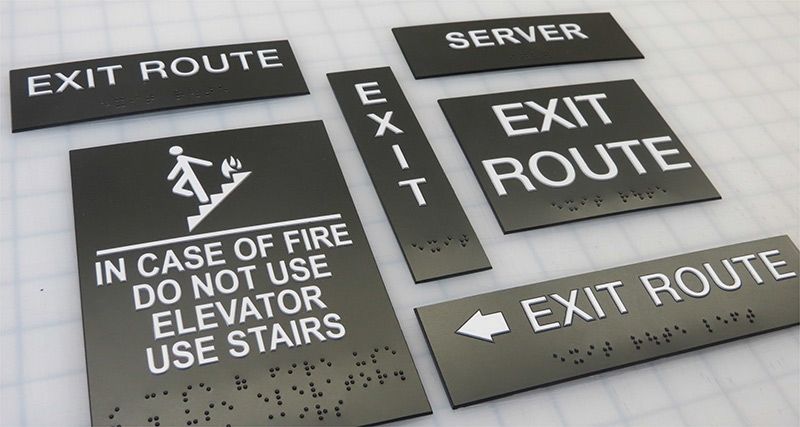Checking Out the Secret Attributes of ADA Indicators for Boosted Access
In the realm of availability, ADA signs serve as quiet yet powerful allies, guaranteeing that areas are comprehensive and accessible for individuals with specials needs. By integrating Braille and tactile components, these signs damage barriers for the aesthetically damaged, while high-contrast color schemes and readable typefaces cater to diverse aesthetic demands.
Significance of ADA Conformity
Making sure compliance with the Americans with Disabilities Act (ADA) is crucial for fostering inclusivity and equal gain access to in public areas and work environments. The ADA, enacted in 1990, mandates that all public facilities, employers, and transport solutions accommodate individuals with handicaps, guaranteeing they enjoy the same legal rights and possibilities as others. Conformity with ADA standards not only fulfills lawful obligations however additionally enhances an organization's reputation by showing its commitment to diversity and inclusivity.
One of the crucial elements of ADA compliance is the execution of accessible signage. ADA signs are designed to ensure that individuals with impairments can quickly navigate through buildings and spaces. These signs should abide by details standards pertaining to dimension, font style, shade comparison, and placement to guarantee visibility and readability for all. Correctly implemented ADA signage assists eliminate obstacles that individuals with specials needs often run into, therefore promoting their freedom and confidence (ADA Signs).
Moreover, sticking to ADA regulations can mitigate the threat of prospective penalties and legal effects. Organizations that stop working to adhere to ADA guidelines might encounter fines or claims, which can be both damaging and financially burdensome to their public picture. Thus, ADA compliance is important to promoting a fair atmosphere for every person.
Braille and Tactile Elements
The unification of Braille and tactile aspects right into ADA signs embodies the concepts of access and inclusivity. It is commonly placed under the corresponding text on signage to make sure that individuals can access the details without visual support.
Responsive aspects expand beyond Braille and consist of elevated signs and characters. These components are made to be noticeable by touch, permitting individuals to identify room numbers, bathrooms, exits, and various other essential locations. The ADA sets certain guidelines concerning the dimension, spacing, and positioning of these tactile components to maximize readability and make certain consistency across various atmospheres.

High-Contrast Color Systems
High-contrast color pattern play an essential role in boosting the exposure and readability of ADA signs for people with aesthetic disabilities. These plans are necessary as they make best use of the difference in light reflectance in between text and background, guaranteeing that indicators are easily discernible, even from a range. The Americans with Disabilities Act (ADA) mandates click to read using certain color contrasts to suit those with limited vision, making it an important element of check these guys out compliance.
The efficacy of high-contrast shades hinges on their capability to stand apart in various lights conditions, consisting of dimly lit environments and areas with glare. Usually, dark message on a light background or light message on a dark background is employed to accomplish ideal contrast. Black text on a yellow or white background supplies a stark visual distinction that helps in fast recognition and understanding.

Legible Fonts and Text Dimension
When taking into consideration the layout of ADA signage, the choice of understandable font styles and proper text dimension can not be overemphasized. The Americans with Disabilities Act (ADA) mandates that font styles have to be not italic and sans-serif, oblique, script, extremely decorative, or of uncommon kind.
The size of the message likewise plays a critical duty in access. According to ADA guidelines, the minimal text height must be 5/8 inch, and it should increase proportionally with viewing distance. This is specifically vital in public rooms where signage requirements to be read rapidly and accurately. Uniformity in text dimension adds to a natural visual experience, assisting individuals in navigating atmospheres successfully.
Furthermore, spacing in between letters and lines is indispensable to clarity. Adequate spacing avoids characters from appearing crowded, boosting readability. By adhering to these requirements, developers can substantially improve access, guaranteeing that signs offers its intended function for all people, no matter their visual capacities.
Effective Positioning Methods
Strategic placement of ADA signs is important for optimizing accessibility and making sure conformity visit this site right here with legal requirements. Effectively located signs assist individuals with handicaps effectively, helping with navigating in public areas. Trick considerations consist of exposure, distance, and elevation. ADA guidelines state that indicators ought to be installed at a height in between 48 to 60 inches from the ground to ensure they are within the line of sight for both standing and seated individuals. This conventional elevation variety is crucial for inclusivity, making it possible for wheelchair users and people of differing elevations to accessibility details easily.
In addition, indications have to be put adjacent to the lock side of doors to allow very easy identification prior to entry. Uniformity in sign positioning throughout a facility boosts predictability, decreasing confusion and enhancing overall individual experience.

Final Thought
ADA indicators play a crucial function in advertising ease of access by incorporating attributes that deal with the requirements of people with impairments. Including Braille and responsive elements guarantees critical information comes to the aesthetically damaged, while high-contrast shade schemes and clear sans-serif font styles boost visibility across different illumination problems. Reliable positioning strategies, such as ideal mounting heights and tactical locations, even more assist in navigation. These aspects collectively foster a comprehensive setting, underscoring the significance of ADA conformity in making certain equal gain access to for all.
In the world of access, ADA indicators offer as silent yet powerful allies, making certain that rooms are inclusive and navigable for people with specials needs. The ADA, passed in 1990, mandates that all public centers, employers, and transportation solutions suit people with specials needs, ensuring they delight in the very same rights and opportunities as others. ADA Signs. ADA signs are developed to make certain that people with disabilities can quickly navigate through rooms and structures. ADA standards stipulate that indications need to be installed at an elevation between 48 to 60 inches from the ground to ensure they are within the line of view for both standing and seated individuals.ADA signs play an important role in promoting ease of access by integrating functions that deal with the demands of individuals with impairments
 Joseph Mazzello Then & Now!
Joseph Mazzello Then & Now! Michael Bower Then & Now!
Michael Bower Then & Now! Romeo Miller Then & Now!
Romeo Miller Then & Now! Alexa Vega Then & Now!
Alexa Vega Then & Now! Shannon Elizabeth Then & Now!
Shannon Elizabeth Then & Now!